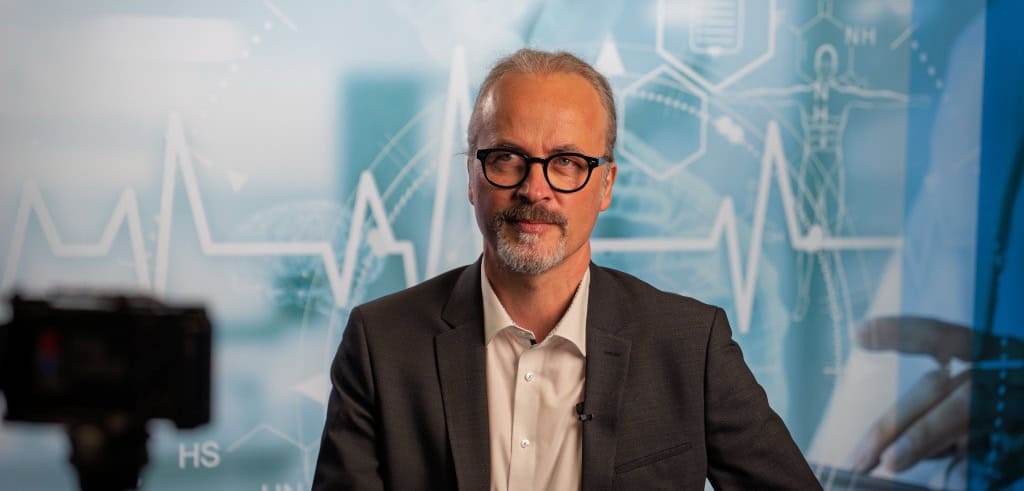EMR fatigue is real, despite the improvements it has brought to health management, says Dedalus Chief Medical Officer Dr Dennis Rausch. But he says there are ways to make life easier for clinicians, and there is a big difference between “general UX and clinical UX.”
Dr Rausch, anaesthetist and global digital health leader, has first-hand knowledge of the stressors on clinicians. He says their focus is on clinical work, not on the invisible processes behind the scenes. Because of this, they often lack motivation to put effort into generating structured, high-quality data.
He said: “Clinicians don’t care about structured data. They care about patients. Structured data is invisible to them. If you want to change that, you need to show them the benefit in their daily life.”
Problems with EMRs
In his leadership role at Dedalus, which is a global award winner in electronic medical record (EMR) implementation across Europe, he acknowledged EMRs can be a “major source of frustration for clinicians”.
“Even the best systems sometimes make doctors want to throw the computer against the wall. We also contributed to this problem with our own systems. That’s why we asked ourselves: what can we do better?”
He says Dedalus identified eight key areas for improvement to significantly advance their EMR capabilities:
- Clinical safety (indispensable).
- Automation of non-clinical tasks
- Off-the-shelf Standard Clinical Content
- Dashboards
- Natural Language Support
- Context awareness and clinical UX
- Embedded CDS (Clinical Decision Support)
- Workflows
Dr Rausch said: “Clinicians want to use speech, text, natural language. They don’t want to code. The system must be aware of who you are, where you are and what you are doing.”
He differentiated general UX (User Experience) from clinical UX, highlighting that clinical contexts vary widely. “A surgeon needs speech input because their hands are busy. A pediatrician cannot turn away from the child. A radiologist works alone in a dark room. These are very different contexts.”
Poor visualisations can hinder decision-making: “Showing blood pressure as a pie chart — that makes no sense.”
He advocated using design thinking to address these challenges, following five iterative steps:
- Empathise: observe clinical work in real life, through the eyes of clinically experienced IT experts
- Define: describe the problem space in detail
- Ideate: use innovative projects with clinicians and IT experts
- Prototype: early prototyping and agile iteration
- Test: measure performance and user satisfaction
“It is important to test with clinicians directly, since they may not accurately articulate their needs,” Dr Rausch said.
Context matters
Dr Rausch explained there is a tension between structured data and free text.
Traditional forms and mandatory fields often frustrated clinicians, leading to workarounds: “You’re forced to enter something, so you just type nonsense. And then the important things end up in the comment field,” he said.
The solution is a “roundtrip” approach: Converting free text into validated structured data and then generating narrative outputs.
Contextual understanding is critical, he said: “We must recognise if the doctor says, ‘I think it could be pneumonia’ — that is not the same as ‘the patient has pneumonia’. These nuances matter and the system must manage them.”
Traditional EMRs require clinicians to navigate multiple sections separately, making it difficult to answer clinical questions efficiently. “If you want to know if the patient has sepsis, you must look at labs, history, findings. Each time you have a new question, you start from scratch.”
Dr Rausch said dashboards were a solution: “On the landing page in the morning, you see what happened overnight, what you must do today, what is urgent. That’s your orientation hub.”
“Dashboards consolidate data, contextualise it and provide an intuitive overview of the day’s priorities,” he said.
Dashboards can be tailored for specialty-specific needs. “For sepsis, you need lab values, cultures, antibiotics – all in one view. For respiratory patients, you need images, oxygen delivery and vitals. You shouldn’t calculate these things yourself.”
Task-specific dashboards for ward rounds and handovers streamlined workflow, enabling clinicians to access essential information efficiently and safely. The dashboard model allows clinicians to “surf” intuitively instead of navigating rigid tree structures.
Rethinking decision support
Current decision support systems often overwhelm clinicians with alerts and create additional work.
“You might get the same clinical alert from three different systems. That makes no sense. And usually you cannot directly action them, but will have to find out by yourself where and how to implement the recommendations.” Instead, support must be contextual and integrated: “If you search for a drug and the patient has an allergy, the alert must come right there. Not after you prescribe.”
AI, use cases and workflow modeling
Dr Rausch identified the high-impact applications of AI, such as triage, differential diagnosis, summarisation and early detection of acute conditions. “AI can detect acute kidney injury two or three days earlier than the human eye. That is useful.”
He said workflows should be event-driven rather than rigidly pre-modelled: “You don’t need big process models. You have events, you create states, and from there you can plug in modules like decision support.” This enables modularity, flexibility and real-time monitoring of tasks.
Towards the digital twin
The patient record can be viewed as the foundation for a digital twin. The digital twin integrates research and clinical documentation, allowing simulations and predictive modeling: “With the digital twin, you can run simulations and understand what is going on.”
“Today we have vitals, labs, and some free text. Tomorrow we will have much more. In the end, you have the full representation of the patient – the digital twin,” Dr Rausch said.
Dr Rausch was speaking at HIC2025 in Melbourne, organised by the Australasian Institute of Digital Health.





